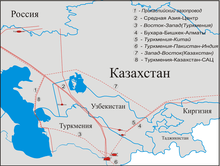Bukhara–Tashkent–Bishkek–Almaty pipeline
The Bukhara–Tashkent–Bishkek–Almaty pipeline is Uzbekistan's main natural gas export pipeline.
| Bukhara–Tashkent–Bishkek–Almaty pipeline | |
|---|---|
 Location of Bukhara–Tashkent–Bishkek–Almaty pipeline | |
| Location | |
| Country | Uzbekistan, Kyrgyzstan, Kazakhstan |
| General direction | west–east |
| From | Bukhara, Uzbekistan |
| Passes through | Tashkent, Shymkent, Taraz, Bishkek |
| To | Almaty, Kazakhstan |
| General information | |
| Type | natural gas |
| Partners | Uzbekneftegas, Kyrgyzgas, KazMunayGas |
| Operator | Uzbekneftegas, KyrKazGas, KazTransGas |
| Commissioned | 1971 |
| Technical information | |
| Maximum discharge | 22 billion cubic meters |
History
Construction of the pipeline started in 1967. In 1968, the pipeline reached to Tashkent, in 1970 to Bishkek (then Frunze) and in 1971 to Almaty.[1]
Description
The diameter of the pipeline is 1,020 millimetres (40 in) and the annual capacity of the pipeline is almost 22 billion cubic meter (bcm) of natural gas.[2] The Bukhara–Tashkent–Bishkek–Almaty pipeline is the main source of gas supply for Kyrgyzstan and southern part of Kazakhstan. It is possible that the pipeline will be connected with the planned Central Asia-China gas pipeline.[3]
Operators
The Kazakhstan section of pipeline is operated by KazTransGas, a wholly owned subsidiary of KazMunayGas. The Kyrgyzstan section of pipe line is operated by KyrKazGas, the joint venture of KazTransGas and Kyrgyzgas.
Future developments
The technical condition of the pipeline is alarming, particularly in Kyrgyzstan. Therefore, there are plans for construction of a second trunk gas pipeline and renovation of the existing pipeline.[4]
References
- Brill Olcott, Martha (2006). "The Transport of Turkmen Gas: Existing Alternatives". In Victor, David G.; Jaffe, Amy; Hayes, Mark H. (eds.). Natural gas and geopolitics: from 1970 to 2040. Cambridge University Press. p. 222. ISBN 978-0-521-86503-6. Retrieved 2009-07-19.
-
Sagdullaev, Djakhangir (2005). "Energy Policy, Economic Cooperation, and Sustainable Development in Central Asia: the case of Uzbekistan" (PDF). Justus-Liebig-Universität. Archived from the original (PDF) on 2011-05-22. Retrieved 2008-02-16. Cite journal requires
|journal=(help) - Ögütçü, Mehmet (2006-10-02). "Kazakhstan's expanding cross-border gas links. Implications for Europe, Russia, China and other CIS countries. Presented at the Windsor Energy Group's Regional Pipelines Roundtable, Almaty" (PDF). The CEPMLP Internet Journal. The Centre for Energy, Petroleum and Mineral Law and Policy at the University of Dundee. 17 (8). Archived from the original (PDF) on 2007-09-29. Retrieved 2008-02-16.
-
"Energy". The European Commission's Delegation to Kazakhstan, Kyrgyzstan and Tajikistan. 2006-12-04. Retrieved 2008-02-16. Cite journal requires
|journal=(help)
Further reading
- Chow, Edward, "Central Asia’s Pipelines: Field of Dreams and Reality," in Pipeline Politics in Asia: The Intersection of Demand, Energy Markets, and Supply Routes (National Bureau of Asian Research, 2010)